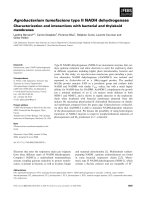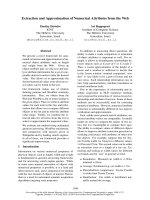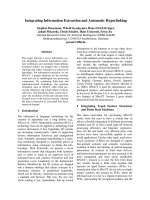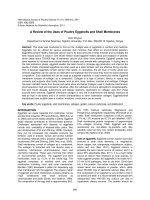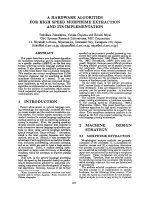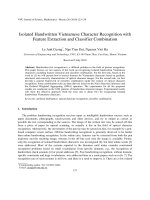solvent extraction and liquid membranes
Bạn đang xem bản rút gọn của tài liệu. Xem và tải ngay bản đầy đủ của tài liệu tại đây (8.34 MB, 364 trang )
Fundamentals and Applications
in New Materials
SOLVENT
EXTRACTION
and LIQUID
MEMBRANES
DK1115.indb 1 3/5/08 12:42:59 PM
DK1115.indb 2 3/5/08 12:42:59 PM
CRC Press is an imprint of the
Taylor & Francis Group, an informa business
Boca Raton London New York
Fundamentals and Applications
in New Materials
SOLVENT
EXTRACTION
and LIQUID
MEMBRANES
Edited by
Manuel Aguilar
José Luis Cortina
DK1115.indb 3 3/5/08 12:42:59 PM
CRC Press
Taylor & Francis Group
6000 Broken Sound Parkway NW, Suite 300
Boca Raton, FL 33487‑2742
© 2008 by Taylor & Francis Group, LLC
CRC Press is an imprint of Taylor & Francis Group, an Informa business
No claim to original U.S. Government works
Printed in the United States of America on acid‑free paper
10 9 8 7 6 5 4 3 2 1
International Standard Book Number‑13: 978‑0‑8247‑4015‑3 (Hardcover)
This book contains information obtained from authentic and highly regarded sources. Reprinted
material is quoted with permission, and sources are indicated. A wide variety of references are
listed. Reasonable efforts have been made to publish reliable data and information, but the author
and the publisher cannot assume responsibility for the validity of all materials or for the conse‑
quences of their use.
Except as permitted under U.S. Copyright Law, no part of this book may be reprinted, reproduced,
transmitted, or utilized in any form by any electronic, mechanical, or other means, now known or
hereafter invented, including photocopying, microfilming, and recording, or in any information
storage or retrieval system, without written permission from the publishers.
For permission to photocopy or use material electronically from this work, please access www.
copyright.com ( or contact the Copyright Clearance Center, Inc. (CCC)
222 Rosewood Drive, Danvers, MA 01923, 978‑750‑8400. CCC is a not‑for‑profit organization that
provides licenses and registration for a variety of users. For organizations that have been granted a
photocopy license by the CCC, a separate system of payment has been arranged.
Trademark Notice: Product or corporate names may be trademarks or registered trademarks, and
are used only for identification and explanation without intent to infringe.
Library of Congress Cataloging‑in‑Publication Data
Solvent extraction and liquid membranes: fundamentals and applications in new
materials / editors, Manuel Aguilar, Jose Luis Cortina.
p. cm.
Includes bibliographical references and index.
ISBN 978‑0‑8247‑4015‑3 (hardback : alk. paper)
1. Solvent extraction. 2. Liquid membranes. I. Aguilar, Manuel. II. Cortina, Jose
Luis. III. Title.
TP156.E8S62 2008
660’.284248‑‑dc22 2007036221
Visit the Taylor & Francis Web site at
and the CRC Press Web site at
DK1115.indb 4 3/5/08 12:43:00 PM
Dedication
We dedicate this book to our esteemed colleague
Abraham Warshawsky who passed away
during the preparation of his chapter.
DK1115.indb 5 3/5/08 12:43:00 PM
DK1115.indb 6 3/5/08 12:43:00 PM
vii
Contents
Foreword ix
Preface xi
Acknowledgments xiii
About the Editors xv
Contributors xvii
Chapter 1
Liquid–Liquid Extraction and Liquid Membranes in the Perspective of the
Twenty-First Century 1
Michael Cox
Chapter 2
Fundamentals in Solvent Extraction Processes: Thermodynamic, Kinetic,
and Interfacial Aspects 21
Hitoshi Watarai
Chapter 3
Computation of Extraction Equilibria 59
Josef Havel
Chapter 4
Hollow Fiber Membrane-Based Separation Technology: Performance and
Design Perspectives 91
Anil Kumar Pabby and Ana María Sastre
Chapter 5
Solvent Extraction in the Hydrometallurgical Processing and Purication of
Metals: Process Design and Selected Applications 141
Kathryn C. Sole
Chapter 6
Modeling and Optimization in Solvent Extraction and Liquid Membrane
Processes 201
Inmaculada Ortiz Uribe and J. Angel Irabien Gulias
Chapter 7
New Materials in Solvent Extraction 225
Lawrence L. Tavlarides, Jun S. Lee, and Sergio Gomez-Salazar
DK1115.indb 7 3/5/08 12:43:01 PM
viii Solvent Extraction and Liquid Membranes
Chapter 8
Solid Polymeric Extractants (TVEX): Synthesis, Extraction Characterization,
and Applications for Metal Extraction Processes 261
Vadim Korovin, Yuri Shestak, Yuri Pogorelov, and José Luis Cortina
Chapter 9
Solvent Impregnated Resin Applications on Metal Separation Processes 301
Abraham Warshawsky, José Luis Cortina, and Karel Jeřábek
Index 335
DK1115.indb 8 3/5/08 12:43:01 PM
ix
Foreword
The International Solvent Extraction Conferences (ISECs) have been held every
3 years since 1971 in various countries around the world. The 1999 conference
(ISEC99) was held in Barcelona, Spain. It was organized under the concept of being
a “good soup,” so the best ingredients were combined both to have a good taste
and to provide the best healthy nutrition to grow on solvent extraction fundamen-
tals and applications. Under this concept the Organizing Committee decided to
cook ISEC99 with a special ingredient by preceding the conference with a Summer
School addressing the principles and applications of solvent extraction for the ben-
et of students and newcomers to this widely used technique in separation science.
Although this idea of providing short courses on topics related to the main confer-
ence is an established practice elsewhere, this was the rst time such a course was
offered as part of an ISEC. The aim of the course organizers was to provide a fairly
comprehensive overview of the fundamental and practical applications of solvent
extraction, so they contacted a number of internationally recognized experts to talk
about their particular elds of interest.
As a result, this publication represents a good recipe to feed the present and
future newcomers to the solvent extraction community. Thus, the text presents the
perspectives of solvent extraction (SX) in the twenty-rst century, a new focus of fun-
damentals of solvent extraction, renewed topics of calculations on extraction equilib-
ria, liquid membranes, and industrial applications. The book also introduces topics
of new materials and solid sorbents for solvent extraction including the improved
and developing topic of solvent impregnated resins. The content of this publication,
presented with a tutorial focus, will benet the understanding of solvent extraction
for today’s practice.
Michael Cox
Manuel Valiente
DK1115.indb 9 3/5/08 12:43:01 PM
DK1115.indb 10 3/5/08 12:43:01 PM
xi
Preface
Following the activities of the rst School in Solvent Extraction in Barcelona in
1986, and coincident with the 1999 International Solvent Extraction Conference
(ISEC), the second International Solvent Extraction School (ISES) was held in Bel-
laterra, Spain. The school gathered senior and young scientists and engineers with
the main idea of discussing the fundamentals and practice of solvent extraction (SX)
and liquid membranes (LM) and to grow the new ideas and trends to contribute to
the best understanding of applications of SX and LM in the future. The lecturers
were leading experts in solvent extraction and liquid membranes.
One of the conclusions from the International Solvent Extraction Committee
was to recommend to the authors of this book and the chairs of the ISES to produce
a reference book by converting the lectures into written material.
The different uses of liquid–liquid extraction, liquid membranes, and solvent
impregnated materials make the subject important for university students of chemis-
try, metallurgy, hydrometallurgy, and chemical and mineral processing technology.
Some universities offer special courses on separation processes in which those tech-
niques are minor topics in more comprehensive courses. Laboratory experiments on
liquid–liquid and liquid membranes are common in chemical and mineral process-
ing engineering curricula. Because of the breadth of the subject, the treatment in
such courses is often scarce, and more comprehensive text is difcult to nd in a
form suitable for use directly with students.
To meet this demand, and to answer the request of the ISEC, we initiated this
project to develop a simple text suitable not only for students but also for scientists
and engineers in the eld. However, no single scientist or engineer can be an expert
in all parts of the eld. Therefore, it seemed that the best idea was to develop this
book as a joint project among many expert authors, each of whom has in many cases
years of experience in research, teaching, or industrial development. The result is an
international book at a high scientic and technical level.
In this context, we would like to point out that this book represents the effort
to bring together the key important topics dealing with thermodynamics, kinetics,
interfacial behavior, process and plant applications, including chemical and engineer-
ing aspects of new extraction systems based on synthetic materials by the leading
experts at the school. The book is directed toward third- to fourth-year undergradu-
ate and postgraduate chemistry and chemical engineering students as well as toward
researchers and developers in the chemical industry, the mining and mineral pro-
cessing industry, and the waste treatment industry. The book is also intended for
chemical, metallurgical, mineral processing, and waste treatment engineers who
already use this technique but have a desire to understand better or to solve existing
process problems. Furthermore, the book should be useful for researchers in solvent
extraction who wish to learn about its applications in areas other than their own.
DK1115.indb 11 3/5/08 12:43:02 PM
xii Solvent Extraction and Liquid Membranes
So, after an introduction to SX and LM in the perspective of the twenty-rst cen-
tury (Chapter 1), the following two chapters (Chapters 2 and 3) present the physical
principles (thermodynamics and kinetics) in SX processes and the tools for computa-
tion of the equilibrium and kinetic parameters. They are followed by three chapters
of various industrial applications and process experience on SX and LM (Chapters
4 through 6), including optimization and modeling tools. The three nal chapters
(Chapters 7 through 9) focus on new materials in SX and LM science and technol-
ogy, including functionalized organic and inorganic solid sorbents and solid impreg-
nated sorbents, indicating the research frontiers and future developments in new
materials.
DK1115.indb 12 3/5/08 12:43:02 PM
xiii
Acknowledgments
We the editors want to express our gratitude to the contributors, who made this book
possible through their helpful suggestions and extensive efforts. Professor Michael
Cox, Professor Josef Havel, Dr. Karel Jeřábek, Professor Vadim Korovin, Dr. Anil
Kumar Pabby, Professor Immaculada Ortiz Uribe, Professor Angel Irabien, Dr. Jun
S. Lee, Dr. Sergio Gomez Salazar, Professor Ana María Sastre, Dr. Yuri Shestak,
Dr. Kathryn C. Sole, Professor Lawrence L. Tavlarides, Professor Hitoshi Watarai,
Dr. Yuri Pogorelov, and Professor Abraham Warshawsky worked hard and success-
fully on their chapters and provided us much valuable help. The success of this book
belongs to our distinguished authors.
We thank Nita Lekhwani and David Russell on the initial editorial staff at Mar-
cel Dekker and to David Fausel and Barbara Glunn and the new staff at Taylor &
Francis for their invaluable editorial assistance.
DK1115.indb 13 3/5/08 12:43:02 PM
DK1115.indb 14 3/5/08 12:43:02 PM
xv
About the Editors
Manuel Aguilar, Ph.D., was born in Spain in 1943. He achieved his licentiate stud-
ies in chemistry at the University of La Laguna in Tenerife, Spain with a main focus
in analytical chemistry. From 1965 to 1969 he was assistant lecturer at the University
de Los Andes in Venezuela. From 1970 through 1976 he was research assistant at
the Royal Institute of Technology in Stockholm, Sweden, where he completed his
Ph.D. studies under the supervision of Professor E. Hogfeldt. In 1976 he returned
to Spain and was assistant professor of inorganic and analytical chemistry at the
Universidad Autonoma in Barcelona. Since 1977, he has been professor of chemistry
in the Department of Chemical Engineering at the Universitat Politécnica de Cata-
lunya. Dr. Aguilar has been active in chemical research for many years, with a main
interest in the eld of ionic equilibrium and solvent extraction, and he has published
more than 100 papers in this eld. He has also been involved in the eld of educa-
tion, in which he has published different books and compendia on ionic equilibrium
and has directed two international solvent extraction schools and diverse postgradu-
ate courses in Spain and South America. Dr. Aguilar has been active in equilib-
rium analysis and computers, participating in the production of various programs
for treatment of hydrochemical systems and in the program of virtual laboratory for
experimental laboratory teaching for basic chemistry courses.
José Luis Cortina, Ph.D., was born in Ligüerrre de Cinca, Spain, in 1964. He has
been professor of chemical engineering at the Universitat Politécnica de Catalunya
in Barcelona, Spain, since 2001 and project research technical director at the Water
Technology Center (CETaqua) since 2007. Dr. Cortina received B.Sc., D.Sc., and
Ph.D. degrees from the University of Barcelona in Spain. He has been a visiting sci-
entist at the Polymer Chemistry Department at the Weizmann Institute of Science in
Rehovot, Israel, and at the Center for Process Analytical Chemistry at the University
of Washington in Seattle at the Fiber Optical Chemical Laboratory. Dr. Cortina has
been active in chemical technology research for many years, with a main interest
in the eld of treatment and separation processes for industrial and environmental
applications using solvent extraction and ion exchange, and he has published more
than 70 papers in this eld. During the last several years his research has been cen-
tered on the treatment technologies for soil and groundwater remediation. He has
been a member of the International Committee on Ion Exchange since 2004.
DK1115.indb 15 3/5/08 12:43:02 PM
DK1115.indb 16 3/5/08 12:43:03 PM
xvii
Contributors
Michael Cox
Department of Chemistry
Hertfordshire University
Hateld, Hertfordshire, United
Kingdom
Sergio Gomez-Sakzar
Chemical Engineering and Materials
Science Department
Syracuse University
Syracuse, New York
J. Angel Irabien Gulias
U
niversidad de Cantabria
Santander, Spain
Josef Havel
D
epartment of Analytical
Chemistry
Faculty of Science
Masaryk University
Kotlarska, Czech Republic
Karel Jeřábek
Institute of Chemical Process
Fundamentals
Academy of Sciences of the Czech
Republic
Praha, Czech Republic
Vadim Korovin
Pridneprovsky Scientic Center
Ukrainian Academy of Sciences
Dniepropetrovsk, Ukraine
Jun S. Lee
Chemical Engineering and Materials
Science Department
Syracuse University
Syracuse, New York
Anil Kumar Pabby
Bhabha Atomic Research Centre
Nuclear Recycle Group
Tarapur, Maharashtra, India
Yuri Pogorelov
Pridneprovsky Scientic Center
Ukrainian Academy of Sciences
Dniepropetrovsk, Ukraine
Ana María Sastre
Department of Chemical Engineering
Universitat Politécnica de Catalunya
Barcelona, Spain
Yuri Shestak
Pridneprovsky Scientic Center
Ukrainian Academy of Sciences
Dniepropetrovsk, Ukraine
Kathryn C. Sole
Anglo Research, a Division of Anglo
Operations, Ltd.
Johannesburg, South Africa
Lawrence L. Tavlarides
Chemical Engineering and Materials
Science Department
Syracuse University
Syracuse, New York
DK1115.indb 17 3/5/08 12:43:03 PM
xviii Solvent Extraction and Liquid Membranes
Inmaculada Ortiz Uribe
Universidad de Cantabria
Santander, Spain
Abraham Warshawsky
Department of Organic Chemistry
The Weizmann Institute of Science
Rehovot, Israel
Hitoshi Watarai
Department of Chemistry
Graduate School of Science
Osaka University
Osaka, Japan
DK1115.indb 18 3/5/08 12:43:03 PM
1
1
Liquid–Liquid Extraction
and Liquid Membranes
in the Perspective of the
Twenty-First Century
Michael Cox
CONTENTS
1.1 Liquid–Liquid Extraction 2
1.1.1 Extractants 2
1.1.2 Synergistic Extraction 4
1.1.3 Applications 5
1.1.3.1 Nonferrous Metals 5
1.1.3.2 Precious Metals 10
1.1.3.3 Nuclear Reprocessing 10
1.1.4 Operating Problems 10
1.1.4.1 Extractant Losses 10
1.1.4.2 Solubility Problems—Third-Phase Formation 11
1.1.4.3 Crud 11
1.1.5 Solvent Extraction for Environmental Applications 11
1.1.6 Trends and Future in Solvent Extraction 12
1.2 Liquid Membranes 14
1.2.1 Introduction 14
1.2.2 Surfactant Liquid Membranes 15
1.2.3 Supported Liquid Membranes 16
1.2.4 Applications 16
1.2.4.1 Recovery of Metals 16
Bibliography 17
Books 17
Book Series 18
Conference Proceedings 18
DK1115.indb 1 3/3/08 2:03:26 PM
2 Solvent Extraction and Liquid Membranes
1.1 LIQUID–LIQUID EXTRACTION
Liquid–liquid extraction is now very well established, featuring extensively as a
selective separation process. Liquid membranes are a more recent development,
which as yet have not featured signicantly in industrial applications. This chapter
focuses on the current and future prospects of these techniques largely in the context
of metal extraction, as that is the area in which I have spent most of my time.
It rst addresses the subject of liquid–liquid extraction, dealing in turn with
extractants, systems, and, lastly, equipment.
1.1.1 Extractants
Because metals generally exist in aqueous solution as hydrated ions before the metal
can be extracted into a nonpolar organic phase, the water molecules must be replaced
and any ionic charge reduced or removed. This can be achieved in different ways by
using three types of extractants: acidic, basic, and solvating, which extract metals
according to the following equilibrium reactions:
Acidic: M
z+
(aq)
+ z HA
(aq, or org)
⇔ MA
z (org)
+ z H
+
(aq)
(1.1)
Basic: (n-z)R
4
N
+
(aq or org)
+ MX
n
(n-z)-
(aq)
⇔ (n-z)R
4
N
+
MX
n
(n-z)–
(org)
(1.2)
Solvating: MX
z (aq)
+ mS
(org)
⇔ MX
z
S
m (org)
+ mH
2
O (1.3)
Acidic extractants include simple reagents such as carboxylic acids and organo-
ph
osphorus acids, as well as chelating acids. The latter are often derived from
analytical reagents, such as β-
diketones, 8-hydroxyquinoline, and hydroxyox-
imes. Extraction occurs by a change of the acidity in solution; thus, increasing the
pH of solution increases extraction, and decreasing the pH promotes stripping or
back-extraction. Therefore, by changing the acidity of the system the metal can be
cycled to and from the organic phase.
The extent of extraction also depends on the magnitude of the metal-extractant
formation constant and concentration of extractant. These factors can be combined
with the distribution coefcient in the following equation derived from Equation 1.1
and the law of mass action:
Log D = log K
f
+ zlog[HA] + zpH (1.4)
This equation allows
t
he stoichiometry of Equation 1.1 to be conrmed by con-
s
tructing linear plots of log D versus pH and log D versus log[HA]. Note in situations
where the extractant cannot satisfy both the coordination number and ionic charge of
the metal ion, then additional nonionized extractant molecules can be added to the
complex (Equation 1.5). In this case the linear log D versus log[HA] plot will have
a slope of (z + s).
DK1115.indb 2 3/3/08 2:03:26 PM
Liquid–Liquid Extraction and Liquid Membranes 3
M
z+
(aq)
+ (z + s)HA
(aq, or org)
⇔ MA
z
(HA)
s(org)
+ z H
+
(aq)
(1.5)
As noted already, the extent of extraction depends on the relevant formation
constant of the metal or extractant (K
f
). For metals in the rst transition series this
will generally follow the Irving-Williams series: that is, for divalent metals, V < Cr
< Mn < Fe < Co < Ni < Cu > Zn. Thus, unless other factors are involved copper will
be extracted at lower pH values than the other elements. In addition it is found that
M
4+
> M
3+
> M
2+
> M
+
, so that thorium(IV) will be extracted before iron(III) in turn
before copper(II) before sodium.
Although the majority of acidic extractants is based on oxygen donor groups, some
commercial compounds include a sulfur donor atom. These, of course, would be favored
when the extraction of a soft metal is required. These generally consist of elements in
low oxidation states or the heavier elements in any group in the Periodic Table.
In certain cases, the separation of metals is a result of kinetic rather than ther
-
m
odynamic considerations, such as extraction of copper at a lower pH than iron(III)
by a commercial 8-hydroxyquinoline derivative, Kelex 100 (Cognis, Inc.,
T
ucson,
Arizona, formerly Witco Corporation). If contact is restricted to about 5 minutes
then copper extraction is preferred, but when the reaction is allowed to progress to
equilibrium then the iron is extracted. This is in contrast to the separation of copper
and iron(III) with
β−
hydroxyoximes, such as LIX860 (Cognis, Inc., formerly Henkel
Corporation) or M5640 (Avecia, formerly Zeneca Specialties), which is thermody-
n
amically controlled.
Stripping of the metal from the loaded organic phase is just as important as
extraction, and here this process is achieved quite simply by a change in acidity of
the system. However, it should be remembered that
e
xtractants that extract metals
at low pH values will require more concentrated acid for stripping. Thus, it is not
always a good idea to use the extractant that extracts too well. Also it is important
to realize that extraction and separation is only one process in a hydrometallurgical
ow sheet, and it is necessary to choose the extractant that will most easily interface
with the operations both upstream and downstream.
Basic extractants normally consist of alkylammonium species, although for
analytical applications organophosphonium or organoarsonium compounds may be
used. Quaternary ammonium species as shown in Equation 1.2 or uncharged alkyl
-
a
mmonium compounds may
b
e used as extractants. In the latter case the presence of
excess anions in the system allows the formation of charged species as, for example,
Equation 1.6:
R
3
N + HX ⇔ R
3
NH
+
X
–
(1.6)
In the case of alkylammonium extractants it has been observed that the mag-
n
itude of extraction follows the order R
4
N
+
> R
3
NH
+
> R
2
NH
2
+
> RNH
3
+
with the
size of the alkyl group R generally between 8 and 10 carbon atoms. The structure of
the alkyl groups is important, and by using straight or branched chain substituents
different properties can be found. In commercial practice the trialkylammonium
compounds are generally more
c
ommonly used in spite of their inferior extraction
properties because they are cheaper than the quaternary extractants.
DK1115.indb 3 3/3/08 2:03:26 PM
4 Solvent Extraction and Liquid Membranes
These extractants require the presence of stable anionic metal complexes to form
the extractable ion pair complexes, so that only metals that produce such species can
be extracted with these compounds. The ease of metal extraction follows the mag
-
n
itude of the formation coefcient of the anionic complex. Thus, in halide solution,
gold (III) > iron (III) > zinc > cobalt > copper >>> nickel.
Stripping of the metal from the loaded organic phase can be achieved by causing
the breakdown of either the anionic metal complex with, for example, water, or the
cationic extractant by treatment with a base. The latter will, of course, not work in
the case of the quaternary tetraalkylammonium ions, R
4
N
+
.
Solvating extractants operate by replacing the solvating water molecules around
the aqueous metal complex, making the resulting species more lipophilic. Such
extractants must possess lone pairs of electrons that can be donated to the metal ion,
and the most common donor atoms are oxygen and sulfur. Nitrogen and phosphorus
can also feature as donors but, for a number of reasons, are not generally used. The
types of organic compounds used include those based on carbon—that is, alcohols,
ethers, esters, and ketones with compounds such as dibutylcarbitol, nonyl phenol,
and iso-butylmethylketone (MIBK). Amides, RCONR
2
, have also been proposed
for specialized applications such as the extraction of actinides and precious metals.
However, the most commonly used oxygen-donating solvating extractants are based
on the organophosphorus compounds: alkylphosphates, (RO)
3
PO; alkylphospho-
nates, (RO)
2
RPO; alkylphosphinates, (RO)R
2
PO; and alkylphosphine oxides, R
3
PO.
The donor properties of the oxygen atom follow the aforementioned trend with the
greater the number of C-P bonds, the better the donor; however, for economic rea
-
s
ons trialkylphosphates are the chosen extractants for commercial use, with tri-n-
butylphosphate probably the most widely used extractant worldwide.
Sulfur donor extractants are less common, although dialkylsuldes have been
used in precious metal extraction, and a trialkylphosphine sulde, R
3
PS (Cyanex
471X, Cytec Inc., New Jersey), is available commercially. Such sulfur donating
extractants will need to be considered when extracting and separating soft met
-
a
ls, such as second- and third-row transition metals (e.g., cadmium, mercury, and
palladium).
S
tripping can be achieved by contact with water (Equation 1.3) or by raising the
temperature of the system.
1.1.2 synErgistic Extraction
On occasion, mixtures of two different extractants will enhance the extraction of
a metal above that expected from the summation of the performance of the two
reagents separately. This gives rise to the synergistic factor (SF), dened as follows:
SF = D
AB
/(D
A
+ D
B
) (1.7)
A large number of examples of synergism can be found in the literature, although
very few of these have actually been commercialized. The main reason for the lack
of industrial interest is probably the difculty in maintaining the optimum ratio of
extractants in the organic phase to provide synergism. Different extractant losses
DK1115.indb 4 3/3/08 2:03:27 PM
Liquid–Liquid Extraction and Liquid Membranes 5
through evaporation, water solubility, and entrainment would provide a difcult con-
trol problem.
The most common synergistic system consists of a mixture of an acidic and a
solvating extractant acting on a metal ion where the preferred coordination number
cannot be satised by just the acidic extractant. For example, a divalent metal ion
with a preferred coordination number of six would form with a bidentate monoba
-
s
ic acid extractant a complex, M(L-L)
2
(H
2
O)
2
, where HL-L is the extractant. The
replacement of the water molecules in the extracted complex with a solvating extract-
a
nt (S) will make the complex much more lipophilic, M(L-L)
2
S
2
and thus will give a
higher distribution ratio. It is very unlikely that the solvating extractant will extract
the metal ion by itself; therefore, synergism occurs.
M
2+
(aq)
+ 2H(L-L)
(org)
+ 2S ⇔ M(L-L)
2
S
2 (org)
+ 2H
+
(aq)
+ xH
2
O (1.8)
1.1.3 applications
Currently, approximately 40 extraction reagents are commercially available for the
recovery of metals. These represent the main categories of acidic, basic, and solvat-
i
ng reagents (Table 1.1). Some of these extractants like tri-n-butylphosphate (TBP),
Versatic acid, and the various amines have been around since the use of liquid–liquid
extraction was proposed for the extraction of metals in the 1950s. Others are much
more recent introductions. It is interesting to note that although 40 reagents are listed
in Table 1.1, only about a dozen are in daily use.
In this section the current status of commercial extractants are considered to set
the scene for possible future trends.
1.1.3.1 Nonferrous Metals
1.1.3.1.1 Copper
The introduction of chelating acidic extractants such as the hydroxyoxime mixture
LIX64N in the mid 1960s revolutionized the recovery of copper from acidic leach
liquors and its separation from iron(III). Since the rst introduction of this reagent,
several developments have taken place to improve operating performance and to
provide subtle modications to suit particular leach liquors. However, there has not
been any development to challenge the position of the salicylaldoximes of the Ave
-
c
ia (Acorga reagents) and Henkel (Cognis, Inc.) (LIX reagents) in this market. The
alternative reagent, Kelex 100 (Witco Corporation), based on 8-hydroxyquinoline—
which was originally formulated for this process—was not really successful because
as noted already the separation was based on extraction kinetic. Also, the reagent
was easily protonated by the acidic strip solutions, which then required a water wash
so that in the overall process a water balance could not be maintained.
The reagent Acorga CLX-50 was a novel introduction about 10 years ago based
on a pyridine dicarboxylic ester. This behaved as a solvating reagent and recovered
copper from chloride media as the complex CuL
2
Cl
2
but has only been used on a
pilot scale.
DK1115.indb 5 3/3/08 2:03:27 PM
6 Solvent Extraction and Liquid Membranes
TABLE 1.1
Liquid–Liquid Extraction Reagents
Type Examples Manufacturers Commercial Uses
Acid Extractants
Carboxylic acids Naphthenic acids
Versatic acids
Shell Chemical Co Cu/Ni separation, Ni
extraction
Yttrium
extraction
Alkyl phosphoric
acids
Mono-
alkylphosphoric
acids
Di-alkylphosphoric
acids and sulfur
analogs
Mobil Chemical Co (MEHPA/
DEHPA mixture)
Avecia formerly Zeneca
Specialties (Acorga SBX50)
Daihachi Chem Ind Co Ltd
(DP-8R, DP-10R, TR-33,
MSP-8)
Bayer AG (BaySolvex
D2EHPA, D2EHTPA VP Al
4058)
Albright and Wilson Americas
(DEHPA)
Hoechst (PA216, Hoe F 3787)
Fe removal
Sb,Bi removal from
copper electrolytes
Uranium extraction
Rare earth extraction
Cobalt/nickel
separation
Zinc extraction, etc.
Alkyl phosphonic
acids
2-ethylhexylphos-
phonic acid 2-
ethylhexyl ester,
and sulfur analog
Daihachi Chem Ind Co Ltd (PC
88A)
Albright and Wilson Americas
(Ionquest 801)
Bayer AG (BaySolvex VP-AC
4050 MOOP)
Cobalt/nickel
separation
Rare earth
separation
Alkyl phosphinic
acids
di-alkyl phosphinic
acids and sulfur
analogs
Daihachi Chem Ind Co Ltd
(PIA-8)
Cytec Inc (Cyanex 272, 302,
301)
Cobalt/nickel
separation
Zinc and iron
extraction
Aryl sulfonic acids Dinonylnaphthalene
sulfonic acid
King Industries Inc (Synex
1051)
Magnesium
extraction
Chelating Acid Extractants
Hydroxyoxime
derivatives
α-alkarylhydrox-
imes
(LIX63)
β-alkylarylhy-
droxyoximess
(LIX860) (M5640)
Cognis Inc formerly Henkel
Corp (various e.g., LIX860)
Avecia formerly Zeneca
Specialties (various e.g.,
M5640)
Inspec (MOC reagents)
Copper extraction
Nickel extraction
8-hydroxyoxine
derivatives
Kelex 100, 120
LIX26
Witco Corp
Cognis Inc formerly Henkel
Corp
Gallium extraction
Proposed for copper
extraction
β-diketone
derivatives
LIX 54
Hostarex DK16
Cognis Inc formerly Henkel
Corp
Hoechst
Copper extraction
from ammoniacal
media
DK1115.indb 6 3/3/08 2:03:27 PM

